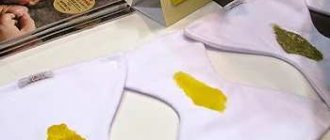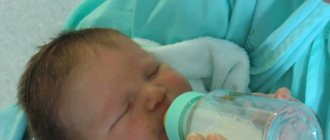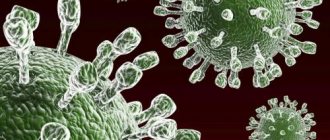Malfunctions in the functioning of a child’s body can be recognized by several signs, one of them is the color and consistency of stool. What should a newborn's normal stool look like when bottle-fed, how to recognize diseases, what measures to take.
- Determining normal stool
- Diarrhea
- Constipation
- What should parents do?
- Green chair
Determining normal stool
Due to the difference in nutrition, the feces of a baby and an artificial baby are different. The color of the stool, its consistency, smell and how often the baby walks helps determine the norm and deviations from it.
The color depends on the selected food.
If it is dark yellow or dark orange, this is normal. Small white grains should not be scary either. A newborn may not immediately absorb all the food. After some time, these inclusions will disappear.
If your baby's stool contains white lumps that look like cottage cheese, it's time to reduce the portions of food. This is a sign of overeating, which is accompanied by liquefied stool.
A bright orange or bright yellow hue indicates liver problems. You cannot do this without the help of a pediatrician.
Green stool in newborns older than 7 days occurs due to dysbacteriosis and other diseases.
Dark shades also indicate some kind of disturbance in the functioning of the child’s body. If there is blood in the stool, the dry stool may have scratched the rectum.
It may also be a sign of certain diseases. In any case, contact your pediatrician with this problem.
Consistency . Before complementary feeding is introduced, normal stool has the consistency of porridge. Too hard or loose stool is a reason for parents to reconsider their child’s nutrition and supplementation.
The harder the stool, the more uncomfortable the child will be. In addition, hardening can cause constipation. With liquid stool, the color, smell and number of times you have bowel movements usually change.
This signals intestinal infections or intolerance to the selected mixture.
The smell of feces during artificial feeding is stronger than when breastfeeding. You should be alarmed if there is a smell of rot.
If foam is present during emptying, it is necessary to get tested. This is a sign of an intestinal infection.
How many times does a man have a bowel movement? In the first weeks, emptying up to 6 times is considered normal. In the future - once a day.
Diarrhea
Diarrhea is very loose stool that has a sour smell. This problem is more typical for infants, but it also happens with artificial feeding.
Often accompanied by bloating and increased bowel movements. Irritation may also appear on the baby's bottom, since such feces are highly acidic.
Diarrhea occurs with dysbacteriosis, intestinal infections, purchasing a new formula, the appearance of teeth, early introduction of complementary foods, and rejection of various foods.
Dysbacteriosis.
May appear after treatment with antibiotics. If a child is prescribed such drugs, it is better to immediately take prebiotics or probiotics along with them.
They will help maintain balance in the intestinal microflora.
Intestinal infection.
Appears due to poisoning or lack of hygiene. She is accompanied by high fever and vomiting. The stool may contain mucus or blood.
Make an appointment with a specialist immediately. The child will need to take antibacterial drugs.
Early complementary feeding.
Diarrhea often accompanies the introduction of complementary foods up to 5 months. The baby’s body is not ready to absorb new foods. If diarrhea appears with timely complementary feeding, it means that the product was not suitable for the baby.
That is why you need to introduce new dishes gradually and monitor the reaction for several days. This will help you immediately identify an unsuitable dish and eliminate it for a while.
Changing the mixture.
You should not try a new formula if the previous one suited your baby. Additional stress on the body during adaptation can lead to diarrhea.
Teething.
All the body's strength is devoted to this process. The child becomes practically defenseless against infections. So the first teeth are often accompanied by diarrhea.
Diseases.
Diarrhea often indicates various diseases, problems with the endocrine system, appendicitis and others. It is better to always consult a doctor so that he can determine the exact cause and prescribe treatment.
To help the baby, parents should take measures:
- Avoid dehydration. Its signs: lethargy, drowsiness, dry skin, sunken fontanel, darkened urine. Give your child a drink every 20 minutes, use Regidron (designed to restore fluid).
- Do not self-medicate. Medicines for a child, especially a newborn, should only be prescribed by a doctor.
- Remove all questionable foods from complementary foods.
- Until the child recovers, prepare more liquid food.
Constipation
This is a common problem in bottle-fed babies. If you have stools less than once a day, but there is no pain and the stool is soft, then everything is fine.
Constipation can be identified by painful sensations, a hard tummy and thick stool.
Constipation occurs for several reasons:
Inappropriate mixture. Even good formulas may not be suitable for a child. If by changing your diet you managed to get rid of constipation, then that was the cause.
For children who often suffer from constipation, it is better to use formulations containing probiotics or fermented milk mixtures.
Food expiration date. Difficulty in bowel movements may occur due to an expired product. Be careful when purchasing.
It is better not to take mixtures that will soon expire, not to mention expired.
Consistency of the mixture. Perhaps the standards indicated on the package are not suitable for the baby. Make food more liquid.
Normal consistency of baby stool
Ideal baby stool has a mushy consistency and a light brown color. It should not be completely absorbed into the diaper.
Note! The stool becomes more formed with the start of complementary feeding. Depending on the foods consumed, its shade changes, and pieces of food may appear.
Newborns produce meconium, which is always sticky and thick, reminiscent of motor oil. Even its color is black, it shouldn’t be scary. It appears almost immediately after the baby is born and consists of mucus, water, hair, everything that was digested during intrauterine life. Then the newborn's stool changes, reacting to the mother's milk or formula, and becomes more mushy.
Diarrhea in a child
Diarrhea in an infant can occur due to overfeeding, exposure to poor quality foods, and certain diseases. The loss of only 10% (of body weight) of moisture by the body is critical; for an infant this is about 300 g. Therefore, it is important to understand that diarrhea for an infant can be fatal and to take measures: a child with diarrhea must be constantly given water to drink. To prevent the leaching of salts from the body, a drug for preparing saline solutions, for example “Rehydron”, is added to the water; if it is impossible to go to the pharmacy - a tablespoon of salt + a tablespoon of sugar per 1 liter of water. Give your child a teaspoon every 5-7 minutes. If loose stools recur, you need to call a pediatrician who will prescribe medications to stop diarrhea, and until the doctor arrives, leave a diaper or diaper with loose stools for a visual examination by a specialist.
Possible changes in baby's stool
Blood in the urine of a child - possible causes in infants
Infants are just developing their enzyme and digestive systems, and the appearance of feces changes from birth to one year. So, in the first months of life, babies may develop foamy stools if the mother has eaten too much flour or sweets. As soon as she changes her diet, everything will improve for the baby. If dairy products predominate in the child’s diet, the stool is lighter, but as soon as meat appears, it becomes dark.
Greenish stool is acceptable if the baby is not bothered by anything:
- he is active, mobile;
- sleeps peacefully;
- temperature is normal;
- there are no other alarming symptoms.
Thus, a green tint may appear when switching from breastfeeding to artificial feeding or when the selected formula is not suitable for the baby. If this was noticed once, and then the stool became normal, the usual color and consistency, there is no need to panic. When the condition persists, you should consult a doctor; this may indicate, for example, dysbacteriosis.
During the period of teeth growth, infants' stool becomes more liquid, and some suffer from diarrhea. It is worth checking whether the child’s gums are swollen. If, in addition, he puts everything into his mouth, salivation has increased significantly, you should wait a few days. When the tooth pecks, the stool returns to normal.
Baby is teething
Dependence on the type of feeding
In bottle-fed babies, stools are denser and more viscous. In addition, formula-fed babies usually go to the toilet once a day, as if on a schedule. Children who drink mother's milk have a higher frequency of bowel movements. In addition, in artificial dieters, the stool often takes on a green tint, which is usually explained by the composition of the mixture, namely the high iron content. In breastfed babies, stool becomes green when milk is poorly absorbed or when the number of pathogenic microflora exceeds the beneficial one.
White spots can appear in all children:
- infants drinking milk may not fully absorb it;
- The “artificial children” are not yet accustomed to the mixture, or the parents did not mix it well, leaving lumps.
Constipation in a newborn
Up to three months, the digestive system in infants does not cope well with its functions, and the baby may have constipation. This is a common occurrence for babies who have switched to mixed or artificial feeding.
Newborns whose diet contains only mother's milk rarely suffer from constipation, since milk in the first 3 months of a baby's life has a laxative effect.
You should know the main signs and methods of dealing with constipation. It is important for parents to understand that the absence of stool during the day does not indicate the presence of constipation. In some children, the intestines are designed in such a way that feces are released rarely, but in large quantities. Attention should be paid to the structure of the stool. If for one day or more the baby “has not passed much”, and after excreting feces, it is dry and hard
, then there are grounds to suspect constipation.
Signs of constipation:
How to help a child?
Under no circumstances should an enema
. This can lead to addiction and weakening of the baby's intestinal muscles. As a result, constipation will become common, and the baby will not be able to independently cope with the removal of feces from the body.
It is usually enough to increase the baby’s mobility and change the diet of the nursing mother.
.
Doctors recommend giving the baby a tummy massage
, moving his legs towards the tummy and back, making movements similar to those when pedaling a bicycle.
Mothers are advised to include oatmeal and buckwheat porridge, more fruits and vegetables in their diet. You should turn to laxatives and suppositories only in extreme cases, when all other methods have been tried, but they do not help.
Giving a child laxatives is allowed only after consulting a doctor.
Causes of sticky stool in infants
The child vomited at night - possible causes of nausea after sleep
If your child has sticky stool, it does not necessarily indicate that he or she is sick. There may be several reasons for this:
- Unusual food for a child. This may be due to the fact that the mother ate a new product, or the baby received a portion of an unfamiliar mixture;
- Not drinking enough fluids during the day. “Artificial” drinks must be supplemented to facilitate the absorption of the mixture;
- Increased gas formation, which is a harbinger of constipation;
- Lactase deficiency;
- Lack of nutrients in the baby’s body;
- Mom's milk is too fatty.
Note! If feces sticks to the diaper and is difficult to wash off from the butt, but the baby feels well, this is not considered a pathology. As a child grows, his weight increases, he sleeps peacefully and sweetly, eats with appetite, and there is no need to worry.
Associated symptoms indicating the disease
The child does not eat porridge - possible reasons for refusal
When your child has stool that looks like clay, you should consult a doctor if the following symptoms appear:
- There are visible streaks of blood in the stool, or it is black;
- The child becomes lethargic, capricious, begins to cry for no reason, and his temperature rises;
- Mucus appears in large quantities in the stool, causing an unpleasant odor.
If sticky stool persists for a long time, during which the baby does not gain weight, you should be wary. Usually in such cases a coprogram is prescribed to check the enzyme activity of the intestines. It is possible that the baby’s fat metabolism is impaired, which will be determined by the doctor after the results of the analysis and examination.
Child at a doctor's appointment
Stool color, mucus
The color of stool may vary. There may be a small amount of mucus and greens in the stool of an infant (this depends on the nature of the diet, in particular the mother, if the baby is breastfed), but a larger than usual amount of mucus, especially mixed with blood, or a sharp change in smell (stench) talks about the disease. A certain amount of blood, streaks of blood in the stool can occur with constipation (when the passage of feces is difficult, small vessels in the rectum burst). This is dangerous for the child, since pathogenic microorganisms can get into the cracks and an inflammatory process will develop.
With dysbacteriosis, it is possible to dilute the stool with a large amount of mucus and greens, undigested lumps; or thickening - stool is darker in color, mask-like, with a putrid odor.
Komarovsky about feces as plasticine
Komarovsky urges people not to dig through children's stools, trying to find something dangerous and abnormal. Due to the immaturity of the intestines, a baby’s stool can be anything, even green; foam and mucus, if they are not always present, but are noticeable in small volumes, should not be frightening. The main thing to look out for is a putrid smell and traces of blood.
You also need to assess the baby’s condition: if he is cheerful, active, smiles, eats with appetite and sleeps well, there is no need to invent illnesses for him. You can touch his belly; if it is soft, then most likely the baby has no problems, especially if his weight is regularly growing.
Comments
- @mammonovna. Oh, well, thank God!! Otherwise I started panicking!
- The stool is quite normal. We eat cereals and vegetables. He poops like this every day, it doesn't bother me
— @kleonazarchik, but for me it’s the other way around
— @olyaiva My cat rarely even eats meat. doesn’t eat fish at all.. But Tyoma is happy to have meat puree instead of cat food
— @kleonazarchik yes, I give Nuk from a bottle)
— @kleonazarchik, and about meat puree, my cat refused to eat it(
— @kleonazarchik, on the one hand, you are right, but on the other, what is added to baby purees is not entirely clear. The composition is ideal, but the taste is very different from the presented composition. I cook it myself, and when I gave my son purees from different brands, it spilled out
— @lena.naeko Thank you, I’m also thinking of trying the compote.. Does he drink from a bottle? It’s just that ours mostly refuses only from a spoon maybe..
— @olyaiva I’m afraid I won’t find good vegetables in the store. Who knows what they were sprayed with.
— @mimimam Yes, it doesn’t seem to bother me.
— @diana0505 Thank you! We'll watch. They seem to be the same, it’s just that there are more microelements.
— @kleonazarchik sorry, I didn’t see that you are already 6) preggy says 5
— @gugnevich Well, because we are already 6 months old. on the mixture it says from 6 you need to go to the Second stage. In the first session, the growing organism no longer has enough of the microelements it consists of. ..
— Perhaps mixture 2 was not suitable for you because the compositions are different from 1, since rash and dry skin are similar to allergies and dense stools may be due to the mixture
Complications and consequences
Plasticine stools often cause constipation. The child cannot go to the toilet on his own, he strains, screams, and feces begins to come out in small portions. In addition to visible discomfort, this condition can lead to:
- Losing body weight;
- Impaired absorption of nutrients in the intestines.
Prolonged constipation can contribute to intoxication of the body, so it is necessary to take measures to improve the baby's stool. Lack of stool and insufficient water intake accompanies dehydration. After all, it is the lack of fluid that often causes problems with bowel movements. This is usually not a problem for babies born on a guardian basis, because milk consists of 80% water, and children born on a livestock diet must be given extra food.
In any case, if plasticine feces persist in the baby for a long time, it is necessary to visit a doctor. Self-medication can harm the baby. The doctor will determine whether the child has enough enzymes and, if necessary, will send him for an ultrasound of the abdominal cavity. If a pathology is identified that needs to be treated, he will prescribe a course of drugs approved for the baby and determine the correct dosage.
Constipation in a child
Constipation is a slow movement of food through the intestines, while putrefactive processes occur in the intestines and toxins are formed that disrupt the child’s condition. With constipation, stool is dense and thick, and comes out in the form of a traditional “poop.” Compaction of feces can lead to injury to the anal mucosa and the appearance of cracks.
Prevention measures
To prevent your baby from having plasticine-like stools, you need to be careful about your diet:
- If a child eats exclusively mother’s milk, then she should be the one who eats healthy foods. There is no need to adhere to diets, but it is better to eat prohibited foods with caution;
- When the baby is bottle-fed or mixed-fed, the choice of formula must be approached responsibly. It is not recommended to constantly change them. You need to make the transition gradually, replacing feedings one at a time. The same applies to the cessation of breastfeeding and the introduction of adapted mixtures;
- Complementary feeding must be started in a timely manner, according to age recommendations, using approved products. So, when introducing adult food, children first get acquainted with green vegetables, then move on to dairy-free cereals.
Proper drinking regimen will help avoid many digestive problems.
Note! The child also needs sufficient physical activity; gymnastics is often used as a way to treat colic and constipation.
Gymnastics
To understand why a baby's feces are like plasticine, you first need to reconsider the diet. A one-time detection of such a consistency does not lead to problems; its chronic nature causes a lot of inconvenience to the child and provokes complications. A gastroenterologist will help determine the cause of stool disorder and prescribe treatment.









